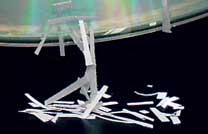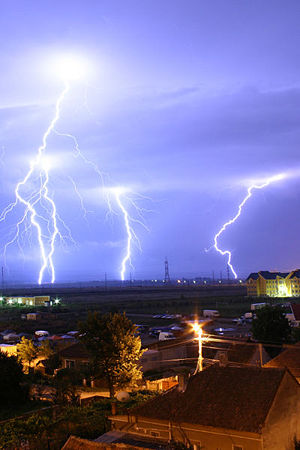Electrostatics
- For a less technical introduction, see Static electricity.
| Electromagnetism | ||||||||||||

| ||||||||||||
Electricity ·Magnetism
| ||||||||||||
Electrostatics is a branch of science that involves the investigation of phenomena related to what appear to be stationary electric charges. Such phenomena are known as electrostatic phenomena.
It has been known since ancient times that the rubbing of some materials gives them the ability to attract small, light objects. Such materials were found to have acquired an electric charge. Amber, for example, can acquire an electric charge by friction with a material like wool. This property, first recorded by Thales of Miletus, suggested the word "electricity" from the Greek word for amber, èlectròn. Other examples of materials that can acquire a significant charge when rubbed together include glass rubbed with silk, and hard rubber rubbed with fur.
Although electrostatically induced forces seem to be rather weak, the electrostatic force between an electron and a proton, that together make up a hydrogen atom, is about 40 orders of magnitude stronger than the gravitational force acting between them.
Examples of electrostatic phenomena include the attraction of plastic wrap to one's hand when removing it from a package, the damage of electronic components during manufacture, and the apparently spontaneous explosion of grain silos. The principles of electrostatics are utilized in the operation of photocopiers.
History
The natural phenomenon of static electricity has been known since early history. It was recorded by Thales of Miletus in the sixth century B.C.E. Scientific research into the subject began when machines were built to create static electricity artificially, such as the friction generator developed by Otto von Guericke in the seventeenth century. The connection between static electricity and storm clouds was famously demonstrated by Benjamin Franklin in 1750.[1][2]
Before 1832, physicists thought that static electricity was somehow different from other forms of electricity. Then in 1832, Michael Faraday published the results of an experiment demonstrating that the electricity induced by a magnet, voltaic electricity produced by a battery, and static electricity were all the same. Since the time of Faraday's result, the history of static electricity merged with the study of electricity in general.
Static electricity
88888888888 "In the late 18th century, scientists developed sensitive instruments for detecting 'electrification', otherwise known as electrostatic charge imbalance. The phenomenon of electrification by contact, or contact electrification or contact tension, was quickly discovered. When two objects were touched together, sometimes the objects became spontaneously charged. One object developed a net negative charge, while the other developed an equal and opposite positive charge. It is an obsolete scientific theory that attempted to explain how electricity is generated in an electric battery or, as it was then called, the Voltaic pile. [3]
Contact electrification phenomenon allowed the construction of so-called 'frictional' electrostatic generators such as Ramsden's or Winter's machines, but it also led directly to the development of most modern electrical technology such as batteries, fuel cells, electroplating, thermocouples, and semiconductor junction devices including radio detector diodes, photocells, LEDs, and thermoelectric cells.
History:
The theory held that static electricity was generated by means of contact between dissimilar materials, and was in close agreement with the principles of static electricity as then understood. It was eventually replaced by the current theory of electrochemistry, namely, that electricity is generated by the action of chemistry and the exchange of electrons between atoms making up the battery. An important fact leading to the rejection of the theory of contact tension was the observation that corrosion, that is, the chemical degradation of the battery, seemed unavoidable with its use, and that the more electricity was drawn from the battery, the faster the corrosion proceeded.
In fact, the Volta effect does correspond to a weak electric potential developed by the contact of different metals. This effect was first discovered by Alessandro Volta, and can be measured using a capacitance electroscope comprised of different metals. However, the actual effect is not sufficiently strong to account for the action of electric batteries.
A number of high voltage dry piles were invented between the early 1800s and the 1830s in an attempt to determine the answer to this question, and specifically to support Volta’s hypothesis of contact tension. The Oxford Electric Bell is one example.
Triboelectric contact:
If two different insulators are touched together, such as when a piece of rubber is touched against a piece of glass, then the surface of the rubber will acquire an excess negative charge, and the glass will acquire an equal positive charge. If the surfaces are then pulled apart, a very high voltage is produced. This so-called "tribo" or "rubbing" effect is not well understood. It may be caused by electron-stealing via quantum tunneling, or by transfer of surface ions. Friction is not required, although in many situations it greatly increases the phenomenon. Certain phenomena related to frictionally generated electrostatic charges have been known since antiquity, though of course the modern theory of electricity was developed after the Scientific Revolution."
8888888888888
Static electricity is a buildup of electric charge on the surface of objects due to contact with and rubbing against other surfaces. Electrostatics involves study of the properties associated with such charge buildup. Also, this manner of electrification of materials is known as the triboelectric effect. The polarity and strength of the charges produced differ according to the materials, surface roughness, temperature, strain, and other properties.
For example, electric charge is built up when wool is rubbed against plastic or the soles of shoes rub on carpet. The mild shock one receives when touching a grounded object after walking on carpet is an example of excess electrical charge accumulating in one's body from frictional charging between one's shoes and the carpet. The resultant charge buildup within the body can generate a strong electrical discharge.
When two different materials are brought into contact with or rubbed against each other, electrons are pulled from the surface of one material and relocated on the surface of the other. Thus the surface of the first material becomes positively charged, while the surface of the second material becomes negatively charged. When the latter, negatively charged material touches a positively charged conductor, a spark is produced or a static shock is felt. A similar phenomenon occurs when a material that is positively charged touches a negatively charged conductor.
Although charge exchange happens whenever any two surfaces come in contact and separate, the effects of charge exchange are usually noticed only when at least one of the surfaces has a high resistance to electrical flow. This is because the charges that transfer to or from the highly resistive surface are more or less trapped there for a long enough time for their effects to be observed. These charges then remain on the object until they either bleed off to ground or are quickly neutralized by a discharge.
Static electricity and chemical industry
Although experimenting with static electricity may be fun, sparks produced during electric discharge can create severe hazards in chemical industries that deal with flammable substances. In such cases, a small electrical spark may ignite explosive mixtures with devastating consequences.
A similar charging mechanism can occur within low-conductivity fluids flowing through pipelines—a process called flow electrification. Fluids that have low electrical conductivity (below 50 pico siemens/cm, where pico siemens/cm is a measure of electrical conductivity), are called accumulators. Fluids having conductivities above 50 pico siemens/cm are called non-accumulators. In non-accumulators, charges recombine as fast as they are separated and hence electrostatic charge generation is not significant. In the petrochemical industry, 50 pico siemens/cm is the recommended minimum value of electrical conductivity for adequate removal of charge from a fluid.
An important concept for insulating fluids is the static relaxation time. This is similar to the time constant (tau) within an RC circuit. For insulating materials, it is the ratio of the static dielectric constant divided by the electrical conductivity of the material. For hydrocarbon fluids, this is sometimes approximated by dividing the number 18 by the electrical conductivity of the fluid. Thus a fluid that has an electrical conductivity of 1 pico siemens /cm will have an estimated relaxation time of about 18 seconds. The excess charge within a fluid will be almost completely dissipated after 4 to 5 times the relaxation time, or 90 seconds for the fluid in the above example.
Charge generation increases at higher fluid velocities and larger pipe diameters, becoming quite significant in pipes 8 inches (200 mm) or larger. Static charge generation in these systems is best controlled by limiting fluid velocity.
Bonding and earthing are the usual ways by which charge buildup can be prevented. For fluids with electrical conductivity below 10 pico siemens/cm, bonding and earthing are not adequate for charge dissipation, and anti-static additives may be required.
Electrostatic generators
The presence of surface charge imbalance means that the objects will exhibit attractive or repulsive forces. This surface charge imbalance, which yields static electricity, can be generated by touching two differing surfaces together and then separating them due to the phenomena of contact electrification and the triboelectric effect. Rubbing two nonconductive objects generates a great amount of static electricity. This is not just the result of friction; two nonconductive surfaces can become charged by just being placed one on top of the other. Since most surfaces have a rough texture, it takes longer to achieve charging through contact than through rubbing. Rubbing objects together increases amount of adhesive contact between the two surfaces. Usually insulators, e.g., substances that do not conduct electricity, are good at both generating, and holding, a surface charge. Some examples of these substances are rubber, plastic, glass, and pith. Conductive objects only rarely generate charge imbalance except, for example, when a metal surface is impacted by solid or liquid nonconductors. The charge that is transferred during contact electrification is stored on the surface of each object. Static electric generators, devices which produce very high voltage at very low current and used for classroom physics demonstrations, rely on this effect.
Note that the presence of electric current does not detract from the electrostatic forces nor from the sparking, from the corona discharge, or other phenomena. Both phenomena can exist simultaneously in the same system.
Charge neutralization
Natural electrostatic phenomena are most familiar as an occasional annoyance in seasons of low humidity, but can be destructive and harmful in some situations (e.g. electronics manufacturing). When working in direct contact with integrated circuit electronics (especially delicate MOSFETs), or in the presence of flammable gas, care must be taken to avoid accumulating and suddenly discharging a static charge (see electrostatic discharge).
Charge induction
Charge induction occurs when a negatively charged object repels electrons from the surface of a second object. This creates a region in the second object that is more positively charged. An attractive force is then exerted between the objects. For example, when a balloon is rubbed, the balloon will stick to the wall as an attractive force is exerted by two oppositely charged surfaces (the surface of the wall gains an electric charge due to charge induction, as the free electrons at the surface of the wall are repelled by the negative balloon, creating a positive wall surface, which is subsequently attracted to the surface of the balloon). One can explore the effect with a simulation of the balloon and static electricity.[4]
Applications
Studies in the field of electrostatics have led to the development of a variety of modern electrical and electronic technologies such as batteries, fuel cells, electroplating, thermocouples, and semiconductor junction devices including radio detector diodes, photocells, light-emitting diodes (LEDs), and thermoelectric cells. In addition, the principles of static electricity are commonly used in xerography, air filters, and some automotive paints.
Small electrical components can easily be damaged by static electricity. Component manufacturers use a number of antistatic devices to avoid this.
Mathematical foundations
Coulomb's law
Electric Potential is the amount of work done per unit charge, in bringing an unit positive charge from infinity to that point. The fundamental equation of electrostatics is Coulomb's law, which describes the force between two point charges The magnitude of the electrostatic force between two point electric charges is directly proportional to the product of the magnitudes of each charge and inversely proportional to the square of the distance between the charges. and :
where ε0 is the electric constant, a defined value:
The electric field
The electric field (in units of volts per meter) is defined as the force (in newtons) per unit charge (in coulombs). From this definition and Coulomb's law, it follows that the magnitude of the electric field E created by a single point charge Q is
Gauss's law
Gauss' law states that "the total electric flux through a closed surface is proportional to the total electric charge enclosed within the surface." The constant of proportionality is the permittivity of free space.
Mathematically, Gauss's law takes the form of an integral equation:
Alternatively, in differential form, the equation becomes
Poisson's equation
The definition of electrostatic potential, combined with the differential form of Gauss's law (above), provides a relationship between the potential φ and the charge density ρ:
This relationship is a form of Poisson's equation. Where is Vacuum permittivity.
Laplace's equation
In the absence of unpaired electric charge, the equation becomes
which is Laplace's equation.
The electrostatic approximation
The validity of the electrostatic approximation rests on the assumption that the electric field is irrotational:
From Faraday's law, this assumption implies the absence or near-absence of time-varying magnetic fields:
In other words, electrostatics does not require the absence of magnetic fields or electric currents. Rather, if magnetic fields or electric currents do exist, they must not change with time, or in the worst-case, they must change with time only very slowly. In some problems, both electrostatics and magnetostatics may be required for accurate predictions, but the coupling between the two can still be ignored.
Electrostatic potential (voltage)
Because the electric field is irrotational, it is possible to express the electric field as the gradient of a scalar function, called the electrostatic potential (also known as the voltage). An electric field, , points from regions of high potential, φ, to regions of low potential, expressed mathematically as
See also
- Electromagnetism
- Electrostatic force
- Ionic bond
- Electronegativity
- Electrostatic discharge
- Electrostatic induction
Notes
- ↑ Franklin's Kite. Retrieved July 21, 2008.
- ↑ Krider, E. Philip. January 2006. Benjamin Franklin and Lightning Rods. Physics Today 59 (1): 42. Retrieved July 21, 2008.
- ↑ Willem Hackmann, "The Enigma of Volta's "Contact Tension" and the Development of the "Dry Pile"", appearing in Nuova Voltiana: Studies on Volta and His Times Volume 3 (Fabio Bevilacqua; Lucio Frenonese (Editors)), (2000) pp. 103-119
- ↑ Balloons and static electricity. Physics Education Technology, University of Colorado at Boulder. Retrieved July 20, 2008.
ReferencesISBN links support NWE through referral fees
- Faraday, Michael. 1839. Experimental Researches in Electricity. London: Royal Inst. e-book, available for free via Project Gutenberg, no. 14986.
- Griffiths, David J. 1999. Introduction to Electrodynamics. Upper Saddle River, NJ: Prentice Hall. ISBN 013805326X.
- Halliday, David, Robert Resnick, and Kenneth S. Krane. 1992. Physics. New York: John Wiley & Sons. ISBN 0471804576.
- Haus, Hermann A., and James R. Melcher. 1989. Electromagnetic Fields and Energy. Englewood Cliffs, NJ: Prentice-Hall. ISBN 013249020X.
External links and further reading
- General
- "Man's static jacket sparks alert." BBC News, 16 September 2005.
- Static Electricity and Plastics
- "Can shocks from static electricity damage your health?." Wolfson Electrostatics News pages.
- Invisible wall of static:
- Essays
- William J. Beaty, "Humans and sparks; The Cause, Stopping the Pain, and 'Electric People." 1997.
- Harold Aspden, "Can Gravity be an Electrostatic Force? - A Quantum theory of Gravitation." 2005.
- Books
- William Cecil Dampier, "The theory of experimental electricity." Cambridge [Eng.] University press, 1905 (Cambridge physical series). xi, 334 p. illus., diagrs. 23 cm. LCCN 05040419 //r33
- William Thomson Kelvin, Reprint of Papers on Electrostatics and Magnetism By William Thomson Kelvin, Macmillan 1872
- Alexander McAulay Utility of Quaternions in Physics. Electrostatics—General Problem. Macmillan 1893
- Alexander Russell, A Treatise on the Theory of Alternating Currents. Electrostatics. University Press 1904
Credits
New World Encyclopedia writers and editors rewrote and completed the Wikipedia article in accordance with New World Encyclopedia standards. This article abides by terms of the Creative Commons CC-by-sa 3.0 License (CC-by-sa), which may be used and disseminated with proper attribution. Credit is due under the terms of this license that can reference both the New World Encyclopedia contributors and the selfless volunteer contributors of the Wikimedia Foundation. To cite this article click here for a list of acceptable citing formats.The history of earlier contributions by wikipedians is accessible to researchers here:
The history of this article since it was imported to New World Encyclopedia:
Note: Some restrictions may apply to use of individual images which are separately licensed.















